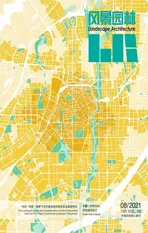气候变化如何改变城市设计
2021-08-24乔纳森巴奈特徐搏谦
著:(美)乔纳森·巴奈特 译:徐搏谦
针对气候变化危害的预测,具体取决于各国温室气体减排的进展。然而,在过去50年中,全球已经排放了大量的温室气体,所有针对21世纪中期的预测都大同小异。温室气体排放逐年增加,增速也并未放缓。目前大气中的温室气体含量已经足以引发气候危机,至2050年,气候危机将更为严峻。问题恶化的态势甚至比科学家几年前的预测更为迅猛:河滨洪泛频发、极端暴雨屡现、山火危机四起、热浪持续不断、粮食、饮用水紧缺。
因为未来设计城市所面临的环境条件将与如今大不相同,城市设计实践正经历着重大变革,将一直持续至21世纪中期。
世界各地的现代城市设计都建立于2个前提之上:一方面,自然环境在数十年,甚至数百年的时间内维持不变;另一方面,工程行业能够根据城市和其基础设施概念改造物质空间。
在沿海岸线及河流的开发建设,在几年前可能毫无争议,如今看起来却不够安全。桥、水坝、防洪墙、地下基础设施等,即使在建设时期满足所有工程指标,如今也可能面临危机。
在现在设计理念的指导下的人工场地,包括动用大量土方整理的、通过填埋洼地创造的、以管道圈围河流的、大面积建筑和硬质铺地覆盖的、优质农田转化为城市建设用地的等,将来则可能不可持续,甚至需要被修复。
我们也要重新思考那些需要大规模制冷制热的玻璃幕墙楼宇、疏于考虑空气流动的建筑排布,以及高度依赖汽车的交通方式。
无论是现在还是将来,保护人类免于气候变化危害的措施因地而异。未来的风险必须通过最准确的科学信息来判定,而如何针对城市进行韧性设计并应对这些风险,将会成为城市设计师、规划师、建筑师、风景园林师和工程师的核心任务。
海平面上升会为沿海地区带来前所未有的且持续反复的洪涝灾害。暴风雨天气中的潮汐起伏会更具破坏力,并波及更遥远的内陆地区。河道内汇集的降雨持续增长,雨水可能会越过甚至冲走防洪墙。强降雨将超过地方雨洪管理能力的荷载。拟定保护措施并转移居民远离危险区域将会成为首要任务。
也需要为部分山火日益频发的地区拟定保护措施,或将居民转移至安全区域。城市需要增设户外纳凉设施、提升空气流动性、鼓励建设耐热建筑,应对持续的炎热天气对城市健康的危害。干旱和极端炎热时,供水受到威胁,导致农作物歉收。保障食物安全也将成为设计的优先任务。
2017年通过的《中国城市设计管理办法》提供了一个范例:一个全国性的气候变暖管理办法,涵盖广泛的城市和风景园林设计问题,以及针对气候变化的规划、建筑、工程要求。
1 洪泛如何影响城市设计
土地与水的关系正处于变化之中,要求我们在开发新空间、重塑旧空间时,采取新的城市设计方法。
1)重新设计滨水走廊。在城市设计领域,将滨水沿岸废弃工业用地改造为公共空间,是提升城市的最重要方式之一。公园、步道,以及餐饮等滨水节点早已普及并大受欢迎。然而,气候变暖无疑将改变这些滨水走廊的设计以及人们的使用方式。目前,在部分海滨城市的滨水走廊周边,海平面上升已经导致潮汐变化加剧、风暴潮危机恶化。滨水公园也将面临海平面上升,以及极端暴雨时更加严峻的洪泛危机。到21世纪中期,所有的公共滨水空间都需要针对海平面上升重新设计,以保护周边城市建设区域免遭洪涝灾害。滨水走廊需要加高、加固。而没有滨水走廊但毗邻水体的场所,则需要采取应对洪泛及巨浪的保护手段,常用方式包括建设集公共设施和防洪墙于一体的多功能滨水走廊。对城市设计师而言,新的挑战将是如何在保持可达性和建造公共设施的基础上,有效地加入洪泛保护措施。
大部分城市滨水走廊的设计都尽可能地拉近人与水的距离,比如船只经常紧沿岸线停泊。然而,为保护城市免受气候变化影响,意味着需要通过建设防波堤、引入红树林或其他保护性湿地来增大人与水的距离。使滨水走廊远离河流、扩展洪泛平原面积则是一种新的雨洪管理方法,其中部分也意味着将原有的城市建成区海绵化,以在洪泛危机时安全地缓存降雨。在洪泛周期性频发的地区,可以将滨水空间设计为高、低2种空间。低空间可以允许其被洪水淹没,恢复常态后通过快速清理再重新向公众开放;高空间则需要保持高于洪水水位线以保护城市边界(图1)。
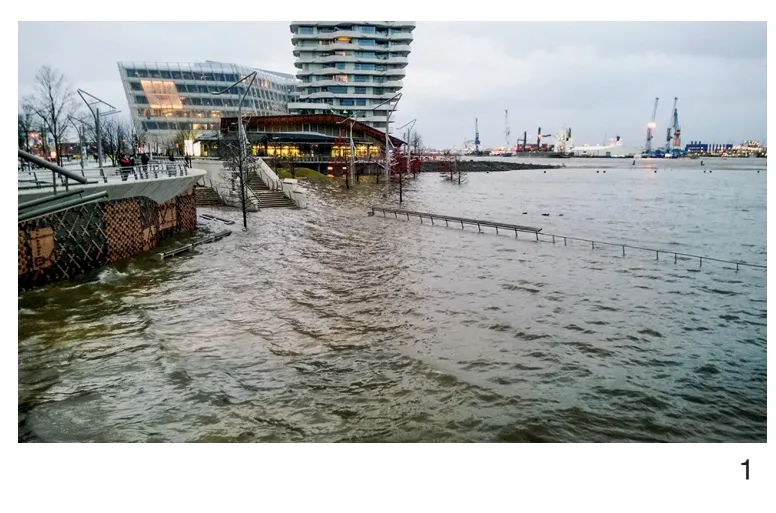
1 汉堡市汉堡港城的马可波罗台地,由巴塞罗那Miralles Tagliabue EMBT事务所设计,用以允许Elbe河在洪泛期可淹没下层低空间。水位下降后,广场可被快速清理,一年中的大部分时间人们都可以走近水岸。上层与街道有相同标高的公共空间则不受洪泛影响。允许汛期河水淹没的设计,将成为滨水空间开发必不可少的一部分The Marco Polo Terrassen, Hafen City Hamburg is designed by the Barcelona Firm, Miralles Tagliabue EMBT so that the Elbe river can flood the lower levels as shown in this photo. When the water goes down, the terraces are easily cleaned,and people can access the edge of the waterfront for most of the year. The portions of the public space up at street level are safe from flooding. As river flooding increases, designing to accommodate it will be a necessary part of waterfront development
2)重新设计公共空间以进行水管理。全球气候变暖将会带来更多的极端暴雨,而强降雨引发的洪泛很可能对城市的排水系统造成负担。城市公共开放空间可以被重新设计为雨洪管理系统,海绵城市政策中的绿色基础设施(图2)。然而现有的公共开放空间选址和设计,通常缺少对自然地形和排水的重视,因此重新设计时需要优先考虑雨洪管理。建筑群内的私有开放空间也应重新设计并纳入雨洪管理系统。另外,还需要评估现有的排水基础设施,尤其是标高较低、排水口可能会因水位上涨而阻塞的管道。
3)强化基础设施抵御洪水的能力。除雨洪系统外,也要评估地下交通系统、沿海铁路和公路、排污管道的尺寸位置,以及现有堤坝防洪墙的稳定性和有效性。部分基础设施可能需要调整或重建以满足新的设计标准。这将是一个大工程,应立即开展研究。
4)强化建筑抵御洪水的能力。需要修正建筑相关的政府规范以保障结构安全,尤其在缺少防洪墙保护的地区,保证建筑能够承受洪泛冲击。供暖通风器械、电梯升降系统和其他装备设施需置于建筑屋顶或高层。建筑的居住层必须远高于洪泛平原,可采取的措施包括填方提升街道、土地、建筑的最低点标高,或通过底层架空抬高建筑。有洪泛风险的城市建成区需要更新甚至重建。建筑规范的调整意味着建筑师、风景园林师和城市设计师必须重新构思城区或乡村设计以保障居民的安全。
5)逐渐搬离无法保护的地区。在一些特殊地区,对建筑和基础设施进行防洪保护可能不切实际或过于昂贵,抬升构筑物、持续提供基础设施支持也将徒劳无功。需要确定这些地区的位置,分阶段地转移居民,尽最大可能减少对其生活造成的干扰。如果某一天这些地区完全无法居住,应确保所有人已经安全转移,将土地退还给大自然。
2 山火如何影响社区设计
山火是一种反复发生的自然过程。当人类和其所拥有的不动产挡住山火蔓延的路线时,山火便成为一个难题。与洪泛危机的日益恶化不同的是,林地和草地中的山火终将熄灭。在山火发生后,自然资源会再生(这一过程对新环境来说更加合理),再次引发山火的概率至少在很多年内会大大降低。但是这种大规模将花费极长的时间,21世纪中期前,山火危机很有可能将一直持续。
1)设计分隔开发区和荒野地。保护人和建筑免遭山火危机的最好方式就是分隔。批准林地中的建筑项目建设一直存在着风险。但是,过去人们知晓酷暑和干旱的周期,认为自己了解山火危机,常用商业保险保证财产安全。然而,随着酷暑季节延长,昆虫侵害森林的时间、树木草地因干热失水的时间也都相应增加。植物难以适应新环境并逐渐凋亡。凋零的植被和干旱的荒原一旦遇到闪电或来自人类的一点星火,一触即燃。
虽然风能带动火跨越开放空间,但也仅限于在有限的距离内传播。在易燃的荒野地中,如果构筑物和小村庄周边有足够宽敞的空间,它们也可能免遭山火之灾。因此,在森林与开发区之间,设计足够宽敞的空间,即防火区,能保护荒野地边界的开发区。存在山火风险的地区需要根据分隔原则重新设计。
一个更复杂的设计问题则是,如何找到未来存在山火风险的地区,并重新设计这些场地以保证人们的安全。长期以来,历史性的公园和林地已经成为城镇的一部分,需要进一步研究来决定如何调整。
2)强化建筑和地区抵御山火的能力。存在山火风险的地区,建筑规范应要求屋顶与墙体使用可防火的建筑材料。门窗和通风口也有必要按照阻隔灰烬和火焰的标准来设计。建筑延伸向外的阳台、门廊,及其他构筑物也使用防火材料,或与主结构保持足够的距离(图3)。
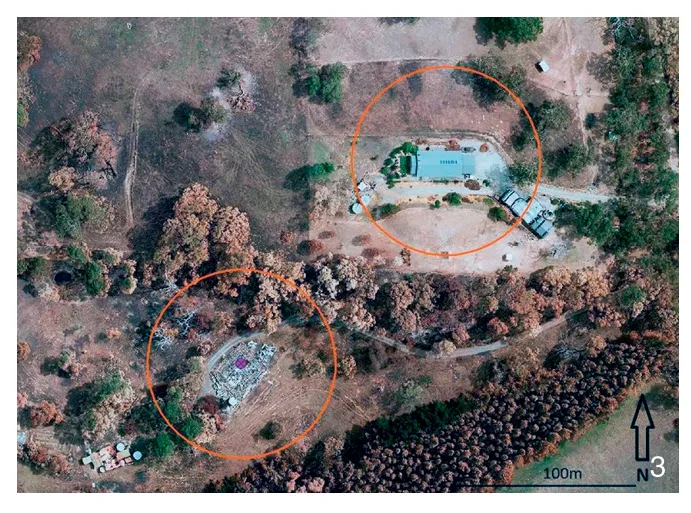
3 照片来自澳大利亚新南威尔士政府,展示了山火后的2处住宅。图中左下的住宅被树林紧密围合,山火轻易地蔓延并烧毁了建筑。图中右上的住宅则因周边空旷而未受影响。在有山火风险的地区,分隔建筑和荒野地、分隔社区和荒野地是基本的设计原则This photo from the government of New South Wales in Australia shows two houses after a wildfire, called a bushfire in Australia. The house at lower left was surrounded by trees, and the fire easily jumped to the building and destroyed it. The house at upper right survived because it is in a more open setting. Separation of individual buildings from wildland, and separating communities from the edges of wildland, are basic principles for designing in places where wildfire is likely
3)逐渐搬离无法保护的地区。如洪涝灾害严峻的地区一样,对某些特殊地区进行防火保护也可能不切实际或过于昂贵。需要分阶段地转移居民,尽最大可能减少对其生活造成的干扰。因为山火危机也许会迅速发展,可能需要尽快行动。某一天如果这些地区完全无法居住,应确保所有人已经安全转移,将土地退还给大自然。
3 热浪如何改变城市和建筑设计
在许多鲜有炎热天气的城市中,连续数周甚至数月不间断的极端酷暑天气正成为一种常态。通过人工制冷系统调节建筑室内温度,不仅会增加能耗,也会将热能转移至建筑周边区域,导致室外环境更加恶劣。建筑师和城市设计师需要重新利用过去没有空调时的自然制冷技术,并在夏季气温过高、长期极端炎热的地区,将其融合至城市设计和建筑规范之中。
1)设计街道、开放空间和建筑以促进自然空气流通。合理的街道及开放空间规划,在白天能够利用盛行风向促进空气流通,更重要的是,在夜晚冷空气可以在城市中流动并驱散积累的热量。建筑设计也可以结合自然气流,利用通风塔使城市上空的冷空气流入建筑,或者在夜晚将冷空气引入建筑底层,推动热空气向上攀升,再从建筑的通风塔中排出。
新的MDF/HDF工厂在北安恰尔邦Sitarganj的安装工作在去年年中开始,在2月28日生产出第一张板材。
2)为街道和建筑遮阴。在密集的城市建设区,大面积种植行道树能够降低环境温度,不仅服务于树荫下的行人,也影响着周边区域。在遮阴树难以存活的炎热干旱地区,可以建造遮阴篷,可考虑用金属结构和遮阳织物材料组合(图4)。
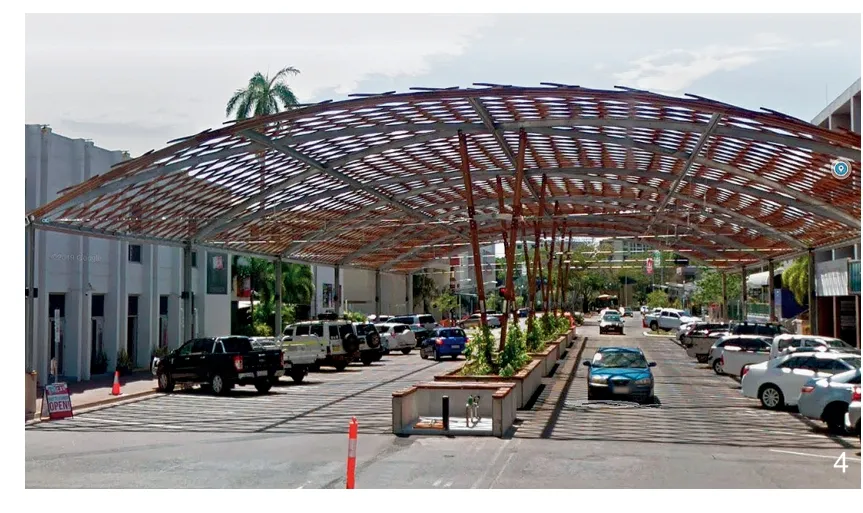
4 北澳大利亚达尔文市跨主商业街建造了这一实验性的遮阴结构,为行人和汽车降温,这一地区的气候不宜遮阴树成长。设计本意是让中间种植池内的藤本植物生长攀爬并覆盖构筑物。尽管从照片拍摄至今植物有一定的生长,但藤本植物仍未生长至完全覆盖构筑物,稍显遗憾。如果这一遮阴结构成型,这条街的其他街区也同样可以复制。如果可以营造一条连续的遮阴廊道,当地的微气候将变得更清凉。也可选择在类似的结构上覆盖织物The city of Darwin, in northern Australia, has built this experimental shade structure across a principal retail street to cool pedestrians, parked cars, and traffic in a climate where shade trees will not grow to be big enough to make a meaningful improvement. The shade is to come from vines which are intended to grow from planters in the middle of the street and spread over the structure. There has been some disappointment that the vines have not yet grown across the whole structure, although there has been progress since this photo was taken. If the shade shelter does become successful,others like it can be built on additional blocks of the street. If an entire shade corridor can be created, it will have a substantial cooling effect for the local microclimate. An alternative method would be to cover a frame similar to this one with fabric
玻璃幕墙建筑本质上是一种加热室内空间的机制。吸收的热能可以通过空调来平衡,但会产生更大的能耗,并将热能转移至周边城区。先进的玻璃技术可以减少热能吸收,但外悬遮阴结构也是一种选择。这种设计理念在20世纪中期颇为流行,但是人们长期以来更喜欢光滑、反光的高层建筑。目前正是设计师和规范制定者们优先考虑减少建筑热量吸收的时机,特别是在极端炎热问题日益严峻的情况下。
4 淡水短缺时的土地和建筑设计
一些地区的降雨减少也是气候变化产生的影响之一,到21世纪中期将会更为严重。
1)治理沙尘暴。沙尘暴是干旱的后果之一,可用种草固土等防沙、治沙措施治理沙尘暴。种植覆土作物并限制播种时的翻土量,能够受减轻耕地风化侵蚀程度。类似的措施亟须在干旱地区大规模采用,也需要在21世纪中期前继续推广。
2)区域生态修复。中国引领着对大尺度区域生态修复的探索,包括森林保护、防风固沙、草原保育。于1994年开展的“黄土高原水土保持”项目,采取限区域批准农耕、放牧和伐木活动的措施,并大规模植树造林,取得的成功已引起了国际上的关注。目前,已有相当一部分地区从过去的干旱、类沙漠土地变为如今的绿地(图5)。这种大尺度的生态修复也会增加降水量,并进一步提升植被覆盖率。

5 中国修复了黄土高原5%的土地,吸引了全球关注,其中包括埃及西奈半岛也尝试了类似的修复。2张照片展示了20世纪90年代中期和近几年的地貌景象。这种转变的产生需要与当地农民紧密合作,改变他们过去的种植、伐木、放牧经验,再从非常细微的尺度重新设计、重新种植。这种生态再生方法可以增加当地降雨量、提升农田产量、改善区域环境The regeneration of about five percent of the land in China’s Loess Plateau has attracted international attention, including plans to attempt a comparable re-greening of Egypt’s Sinai Peninsula. The two photos show the condition of the landscape in the mid-1990s and a few years ago. The transformation required working closely with local farmers to change planting, tree-cutting, and grazing practices and then a redesign and replanting of the landscape at a very detailed level.This kind of landscape regeneration can increase local rainfall, making farms more productive and improving the climate for the whole area
3)减少工业冷却用水。发电厂和其他工厂经常利用溪流中的淡水制冷,再将可能已受到污染的水资源以更高的温度排放回溪流。关闭制冷系统,利用同样的水源反复在场地内流动,通过自然蒸发而散热是一种虽然成本更高但却更简单的替代方案。这种方案需要大面积的制冷池,因此这些工业设施也需要更大的场地。
4)节约灌溉用水。农业生产需要大量的淡水。大量浇灌农田虽然非常简单,也是种植水稻的必要方法,但是大量浇灌其他作物却意味着会因蒸发浪费大量的水资源。喷灌,即通过喷头制造人工降水以大面积覆盖农田,也会因蒸发或无效灌溉而浪费大量水资源。最节水的方法是通过地下多孔管道灌溉。管道系统的设计决定着农田的布局,需要考虑不同的管道容量和农田间距,
5)管理饮用水供给。许多城市因管道泄露而浪费了大量的水资源。如果泄漏率超过10%,水源紧缺的地区就需要制定维修更换计划。相似地,许多家用电器和民用、商用制冷系统,也正大量消耗着不必要的水资源。长年累月,更换后的节水设备会显著减低总耗水量。采集雨水进行园林灌溉,维护建筑周边植被,可以节省稀缺的饮用水资源,因此,居住区和商业区的园林设计需要利用这种方式收集雨水,并储存于容器中,再抽取用于日常园林灌溉。在水资源需求快速增长并超过供给的地区,这些管理方式显得尤为必要。
5 应对未来粮食短缺
到21世纪中期,人口的日益增加,以及种植周期的逐渐变化可能共同导致部分国家粮食短缺,甚至目前粮食供给稳定的国家也不例外。随着种植周期的变化,农作物将不再适应其已经生长了数个世纪的环境。而其他地区的气候却可能会变得更适宜这些作物生长,但土壤条件却很可能有所差异,况且也无法确定农作物可以根据气候环境变化而迁移。粮食生产国会因自身粮食短缺而减少出口,所以依赖进口粮食也并不可靠。
2)充分利用温室农业。用透明塑料或玻璃结构保护农作物,可以延长植物的生长周期,在遮阴设备的保护下也可以保护作物免受过冷或过热的极端温度影响。在承重结构允许的条件下,目前大面积的城市屋顶都可以建设温室。工厂、仓库、停车场和部分商业零售建筑的现有柱结构(或者经过加固以后),都可以支撑温室建设(图6)。新建筑可以在设计中增设屋顶温室。如果能形成足够的规模,温室农业可以解决气候变化引起的部分问题,并扩大可供粮食种植的土地面积。
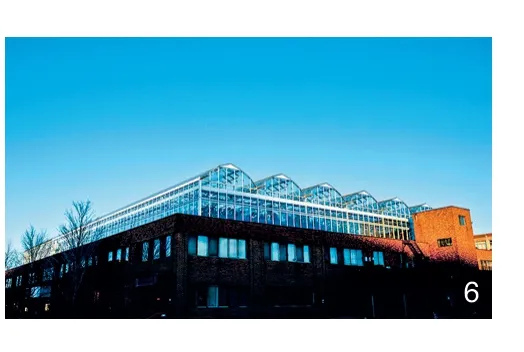
6 加拿大蒙特利尔Lufa Farms的屋顶温室建造于现有仓库结构之上。目前有大量的屋顶可增建温室,也可以在建设新的工业、停车、商业建筑时增建温室。在城区种植食物可以减少运输成本和尾气排放,如果应用于足够多的建筑,这种设计能够提升粮食供给总量This rooftop greenhouse belonging to Lufa Farms in Montreal, Canada was built on top of an existing warehouse structure.There are many hectares of rooftops with the potential to add greenhouses; and greenhouses can also be included when new industrial, parking, or retail buildings are constructed. Food grown in urban areas reduces the costs – and emissions –for transportation; and such designs, if adopted for enough buildings, can improve the over-all food supply
6 气候危机如何影响城镇化政策
数年后,部分土地需要昂贵的防洪或防火保护措施才能为人所用,现在仍然批准这些土地用于城镇化开发,将是非常严重的错误。用以保障粮食安全的农业用地不宜城镇化。洁净水资源短缺的地区也不宜建设高耗水的项目。在现有社区加建和新城选址过程中,也要综合考虑上述因素。所有的非建成区发展规划,都必须包含气候危机管理设计,许多符合过去城镇化选址要求的地区,未来将不再适宜城镇化建设。因为气候已经开始改变,21世纪中期的环境危机近在眼前,调整城镇化政策已迫在眉睫。
注释:
乔纳森·巴奈特及其宾夕法尼亚大学同事马蒂耶斯·布尤所著的新书Managing the Climate Crisis将于2022年由Island Press出版社出版。
图片来源:
图1 © Flor!an根据知识共享署名3.0协议;图2 ©2021 Google;图3 ©新南威尔士州政府;图4 ©2021 Google;图 5 © Ideaa.edu根据知识共享署名4.0协议;图 6 © Lufa Farms根据知识共享署名2.0协议。
(编辑/刘昱霏)
How a Changing Climate Will Transform Urban Design
Author: (USA) Jonathan Barnett Translator: XU Boqian
Predictions about the dangers created by climate change depend on assumptions about how successfully the nations of the world limit emissions of greenhouse gases into the atmosphere. However, all predictions are similar up to the middle of this century, because there has been so much greenhouse gas emitted already,especially in the last fifty years. More greenhouse gases continue to be added every year; and so far there has not been much progress in reducing the rate of accumulation. There is already enough greenhouse gas added to the atmosphere to create climate threats right now and bigger threats by 2050. Problems began much faster than scientists thought likely even a few years ago: rising tides along the coasts, more flooding along rivers, more extreme rain events, increased risk of wildfires,longer heat waves and shortages of food and fresh water.
The practice of urban design is already changing in response, and will be transformed by mid-century because the environmental context for designing cities will be so different.
Modern city design everywhere in the world has depended on the assumption that the natural environment would remain the same for decades,even centuries, and that the engineering profession can always remake the landscape in response to concepts about cities and their infrastructure.
Decisions about building along coasts and rivers, made without question only a few years ago,are beginning to look less safe. Dams, sea-walls,bridges and underground infrastructure that met all engineering requirements when they were built may now be at risk.
Places where land is levelled, or where lowlying land is raised with fill; places where streams are enclosed in pipes; places where almost all the land is covered by buildings or by pavement,places where prime agricultural land is becoming urban – the design decisions that are creating all these places may become unsustainable and need to be corrected.
Glass-walled buildings that need extensive artificial heating and cooling, building placements made without reference to air circulation,heavy dependence on cars and trucks for local transportation - all will need to be rethought.
What needs to be done to keep people safe from climate change now and in the future will be different from place to place. Future risks must be determined using the best scientific information,and responding to these risks with resilient designs for cities will be a central task for urban designers and planners, as well as architects, landscape architects, and engineers.
Rising sea levels can subject coastal areas to repeated flooding, and in a big storm the tidal surge can be more forceful, and extend much farther inland, than has ever been seen before. Increasing volumes of water in rivers can over-top flood-walls and possibly wash them away. Heavier rainstorms can overwhelm local flood management. Designing protections and possibly relocating people away from the most dangerous areas will be a priority task.
In some places more intense and frequent wildfires will also require protections, or people moving to safer places. Longer periods of extreme heat will make cities unhealthy and will require improved outdoor shade and air circulation, and heat-resistant buildings. Periods of drought and extreme heat can endanger water supplies, and cause crops to fail. Designing for food security will be a high priority.
China’s Urban Design Management Approach,adopted in 2017, offers a template for what will be needed: a national Management Approach for a Warming Climate covering a broad range of urban and landscape design issues, plus climate-specific requirements for planning, architecture, and engineering.
1 How Flooding Threats Affect Urban Design
The changing relationships between land and water will require new urban design approaches for developing areas, and redesigns for existing development.
1) Redesigning Waterfront Esplanades. One of the most important ways urban design improves cities has been recapturing waterfronts for public use as the need for industrial land along the edge of the water has diminished. Parks, pedestrian promenades, and waterfront destinations like restaurants have become widespread and very welcome improvements. But a warming climate will inevitably change the design of these esplanades and the way people use them. Rising sea-levels are already bringing higher tides and larger storm surges to the edge of esplanades in coastal cities.Waterfront parks along rivers will also see higher water levels, plus bigger floods from more powerful storm events. By mid-century all public waterfronts will need to be redesigned to accommodate higher water levels and also to help protect adjacent urban development from flooding. The esplanades will need to be both higher and stronger. Places which do not have esplanades now will come to need flood and surge protection, and a new kind of multi-purpose waterfront esplanade, combing public amenities and flood walls will often be the way to protect them. The challenge for urban designers will be to incorporate effective flood defenses while preserving and creating public access and amenities.
Most urban waterfront esplanades have been designed to bring people as close to the water as possible, often with boats moored right along the edge. Protecting cities from the changing climate will sometimes mean separating people from the water by introducing an intervening level of breakwaters or perhaps mangroves or other kinds of protective wetlands. A new understanding of ways to retain and manage floods could also move waterfront esplanades back from rivers to make room for an extended flood plain, part of what is meant by turning urban areas into sponge cities that manage floods by safely retaining the water until the flood danger goes down. Where flooding is periodic, waterfronts may be designed with two levels. The lower level can be designed to flood,and then be easily cleaned and reopened to the public, while a higher level is designed to remain permanently above the water and to protect the urban edge (Fig. 1).
2) Redesigning Public Spaces to Manage Water. Floods from heavy rainstorms can overwhelm a city’s drainage system, and more extreme rain events will be one of the consequences of a warming climate. The public open spaces in cities can be redesigned to become a flood management network, a green infrastructure which becomes a part of sponge city policies (Fig. 2). But existing public open spaces were usually designed and placed without reference to natural land contours and the flow of stormwater, so managing stormwater will have to become a major determinant in redesigning these spaces. There will often turn out to be missing connections that will have to be added to the open space system to make it effective for flood management. Private open spaces belonging to groups of buildings should also be redesigned and added to the system. In addition, the existing stormwater infrastructure will need to be evaluated,particularly where pipes that empty stormwater into rivers or the ocean will become blocked as water levels rise.
3) Making Infrastructure More Flood-Resistant. In addition to stormwater systems,underground transit systems, railways and highways along shorelines, the size and location of wastewater pipes, the stability and effectiveness of existing dams and floodwalls will also have to be evaluated and some are likely to require being modified or rebuilt to new design standards. This will be a massive undertaking and studies should begin right away.
4) Making Buildings More Flood-Resistant.Government regulations for buildings will need to be amended to make sure that structures are safe from flooding, especially if they are in locations that are not protected by flood walls. Heating and air-conditioning machinery, elevator hoist systems,and other equipment will have to be on roofs or on a high floor. Parts of buildings where people live or work will have to be located well above the floodplain, which can mean elevating streets, land, and buildings on fill, or raising individual buildings on columns. Existing urban areas at risk from flooding will need to be retrofitted or rebuilt. These kinds of changes in building regulations mean that architects, landscape architects, and urban designers will have to reimagine whole villages or districts of cities to keep people safe.
5) Incremental Removal of Communities That Cannot Be Protected. There will be some communities where flood protections for buildings and infrastructure will be impractical or too expensive, or where raising structures and continuing to provide infrastructure support will eventually become impossible. These places need to be identified, and plans made for people to be relocated in stages, with as little disruption to their lives as possible. By the time these places are no longer inhabitable, everyone should have moved away and the land returned to a nature.
2 How Wildfire Will Change Community Designs
Wildfire is a recurring natural process. It becomes a problem when people and property are in the way. Unlike threats from flooding, which will only continue to become worse, wildfire in forests and grasslands will eventually be self-limiting. Areas will burn; and regrowth can be more appropriate for a changed environment and less likely to burn again – at least for many years. But such large ecological changes will take a long time, and dangerous wildfire conditions are likely to persist through the middle of this century.
1) Designs that Separate Development from Wildlands. The best way to protect people and buildings from wildfire is to keep them separate.Permitting building in places surrounded by woodlands has always been a risk. But, in the past,when cycles of heat and drought were known and understood, people felt they knew what the wildfire risks were, and insurance was often available. But as warm seasons become longer, there is more time for insects to attack trees, and for heat and drought to dry out trees and grass. As plants become less well-adapted to where they are growing, they begin to die. A dry wildland with a lot of dead vegetation is only waiting for a spark – from lightening or from activities by people – for a fire to begin.
The wind can carry fires across open spaces,but only for a limited distance. When individual structures, or small villages, are surrounded by flammable wildlands, structures may survive if a sufficiently wide space is cleared around them.Development on the edge of wildlands can also be protected if there is a wide enough cleared space,called a fire-break, between the edge of the forest and the development. Places at risk for wildfire need to be redesigned to make them more separate.
A more complicated design problem will be to identify places that will be at risk from wildfire by mid-century, and redesign them to insure that people remain safe. Historic parks and woodlands that have long been part of cities and towns should be studied to see what changes may be needed.
2) Making Buildings and Communities Fire Resistant. Building regulations for places at risk from wildfire should require that construction materials for roofs and walls be fire-resistant. It is also necessary for window, door, and ventilation openings be designed so that embers or flames cannot enter the building. Decks, porches, and other structures connected to the building should also be fire-resistant, or kept well away from the main structure (Fig. 3).
3) Incremental Removal of Communities That Cannot Be Protected. As for places at risk from flooding there may be places where protections from wildfire will be impractical or too expensive.Plans will need to be made for people to be relocated in stages, with as little disruption to their lives as possible. This may be an urgent matter as wildfire risk can develop rapidly. By the time these places are no longer inhabitable, everyone should have moved away and the land returned to a nature.
3 How Heat Waves must Change City and Building Designs
Weeks and even months of extreme heat,with little relief, are becoming normal for cities that seldom if ever had experienced such hot weather. Using artificial cooling machines to moderate building climate indoors not only increases energy use, but the heat is transferred to the areas immediately around the buildings making the outdoor temperatures worse. Architects and city designers need to rediscover natural cooling techniques in use before air-conditioning, and these techniques need to be incorporated into the urban design and building regulations of places where summer temperatures are producing extended periods of extreme heat.
1) Designing Streets, Open Spaces, and Buildings to Facilitate Natural Ventilation. Streets and open spaces can be planned to facilitate ventilation by prevailing winds during the day and – especially important – at night, when cooler air can blow through a city and disperse accumulated heat. Natural ventilation can also be designed into buildings so that cooler air circulating above a city can be brought down into a building from ventilation towers, or cooler air can be let into the lower floors of a building at night, where it can push warm air up and out of the building through the same ventilation towers.
2) Shading Streets and Buildings. Extensive tree planting along streets has been shown to lower temperatures in dense urban areas, not only for people walking in the shade, but also in the surrounding area. In places which are too hot and dry for shade trees, shade structures can be built,perhaps by using a fabric on a metal frame (Fig. 4).
Buildings with glass-curtain walls are a mechanism for heating up the building interior.The heat-gain can be balanced by air-conditioning,but it causes greater energy use and transfers the heat into the surrounding city. Advanced glass technology can reduce heat gain, but external shade structures are a good alternative. They were a fashionable design concept in the middle of the last century, but sleek, reflecting towers have been preferred for a long while. It is time for designers and regulators to give priority to reducing heat-gain in buildings, particularly where extreme heat is an increasing problem.
4 Designing Land and Buildings when Fresh Water is Limited
Diminished rainfall in some areas is a product of a changing climate and is expected to become a more severe problem by mid-century.
1) Limiting Dust-Storms. Dust-storms are one symptom of drought conditions, and it may be possible to limit dust storms by anti-desertification measures, such as planting grasses to hold desert soil in place. Planting cover crops and limiting the amount of soil turned over when planting seeds can reduce wind erosion of cropland. Such measures already need to be adopted at a large scale in areas where drought as a problem, and such efforts need to be widely adopted by mid-century.
2) Regional Ecological Reclamation: China has been a leader in seeking to reclaim large regions from ecological degradation, including forest protection, sand control, and grassland conservation. A success that has attracted international attention has been the Loess Plateau Watershed Rehabilitation Project begun in 1994 with restrictions on where crops were planted, on grazing, and on tree-cutting, followed by extensive replanting. A substantial area has been brought back from dry, near-desert conditions to the green landscape shown in Figure 5. Ecological restoration at this scale can also increase the amount of rainfall, which further reinforces the greening of the landscape.
3) Using Less Water for Industrial Cooling.Power plants and other industries often draw fresh water from streams for their cooling systems,returning the water to the streams at a higher temperature and with the risk of contamination.A simple alternative, although more expensive to build, is to close the cooling system, with the same water recirculating after being cooled by evaporation on site. This method requires a substantial area for the cooling ponds, so the sites for these kinds of industrial installations will need to be much larger.
4) Conserving Irrigation Water. Agriculture requires large amounts of fresh water. Flooding fields is easy to do, and essential for rice cultivation,but flooding other kinds of crops means major losses of water to evaporation. Spray irrigation,where a sprinkler system covers a large area with artificial rain, also wastes a lot of water from evaporation or from irrigating the wrong places.The irrigation method which conserves the most water is to deliver it at ground level through perforated pipes. The design of the pipe system determines the arrangement of the crops being irrigated, with different pipe volumes and spacing for different crops.
5) Managing Drinking Water Supplies. Many urban pipe systems loose a substantial amount of their water to leaks. If system leakage is more than 10 percent, places with limited water supplies need to plan a program for repair and replacement.Similarly, many household appliances – and home and office cooling systems – use more water than they need to. Over time, replacements that use less water can make a substantial difference to overall consumption. Capturing rainwater for landscape irrigation can replace scarce drinking water for maintaining plantings around buildings, so that designs for residential and commercial landscaping need to take advantage of this option, with the flow of irrigation water pumped from cisterns that conserve water after it rains. Where demand is increasing faster than available water resources,these types of management are essential.
5 Planning for Future Food Shortages
The combination of increasing populations and changing growing seasons makes food shortages likely by mid-century even in countries that have stable food supplies now. As growing seasons change, crops can become less well-adapted to the places where they have been successfully cultivated for centuries. The climate in other places may become more suitable for these crops, but the soil conditions are likely to be different and it is not certain that crops can simply move to stay in synchronization with the most favorable climates for them. The alternatives for importing food may become unreliable as exporting countries keep more of their agricultural products at home because of their own food shortages.
1) Conserving Agricultural Land. Uncertainty about future food supplies is a powerful argument for conserving agricultural land, not just the best land, but all land available to grow crops or trees.The assumption that most land adjacent to urban areas can be urbanized needs to change right away.
2) Making More Use of Greenhouse Agriculture. Protecting crops with transparent structures of plastic or glass can prolong growing seasons and shield plants from excessive cold and, with shading devices, also from excessive heat. The vast acreage of existing urban rooftops can support greenhouses when the structure is suitable. Factories, warehouses, parking garages,and some retail buildings have column structures that can support greenhouses, or can be reinforced to support them (Fig. 6). New buildings can be designed with rooftop greenhouses. If organized at a broad enough scale, greenhouse agriculture can off-set some of the problems created by a changing climate, and add to the growing surfaces available to support the food supply.
6 How Climate Threats Will Change Urbanization Policies
It will be a serious mistake to permit urbanization of land that, in a few years, will require expensive protections from floodingor from wildfire - in order to remain usable.Agricultural land that will be needed for food security should not be urbanized. Places at risk of fresh-water shortages also should not be developed to uses that increase the demand for fresh water.These considerations need to be incorporated in procedures for expanding existing communities and for locating new towns. All plans for development in green-field locations will have to include designs for managing climate threats, and many places that met criteria for urbanization in the past will then be understood as places where urbanization should not take place. Because the climate is already changing and a mid-century climate crisis is only a few years away, urbanization policies need to be adjusted now.
Note:
Jonathan Barnett, and his University of Pennsylvania colleague Matthijs Bouw, are the authors of a forthcoming book, Managing the Climate Crisis, to be published by Island Press in 2022.
Sources of Figures:
Fig. 1©Flor!an used according to C.C. 3.0; Fig. 2 © 2021 Google; Fig. 3© Government of New South Wales; Fig. 4 Image Capture 2018 © 2021 Google; Fig. 5© Ideaa.edu used according to C.C. 4.0; Fig. 6© Lufa Farms used according to C.C. 2.0.
